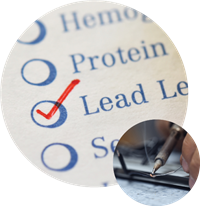
Lead Standard
Potential exposures to lead can occur in many industries, including demolition, painting, plumbing, battery recycling, electronics manufacturing, and more. As established under California Code of Regulations (CCR) Title 8, Section 5198 for general industry and Section 1532.1 for the construction industry, employers must evaluate and control occupational exposures to lead to ensure employees are properly protected.
Yorke Services
Yorke Engineering stands as a distinguished expert in Industrial Hygiene and Safety, offering invaluable assistance in navigating the revised lead standards. We are here to assist with conducting employee air monitoring, as well as developing a written Lead Compliance Plan and Elevated Blood Lead Level Response Plan tailored to your organizational needs. We can also assist with interpreting the latest regulatory requirements effectively for your specific work site, ensuring optimal compliance and safety measures.
Yorke can assist with the following aspects of the lead requirements (detailed below):
- Employee lead exposure monitoring/testing
- Written Lead Compliance Plan
- Written Elevated Blood Lead Level Response Plan
- Response assistance to Cal/OSHA lead investigations
- Respiratory Protection Program development
Revised Standard for Lead
The Department of Industrial Relations (DIR) has updated the regulations, and revised requirements are taking effect on January 1, 2025. These revisions will make significant changes to employer responsibilities.
The amended regulation includes the following changes:
- The Permissible Exposure Limit (PEL) will be reduced to 10 micrograms per cubic meter (µg/m3) from 50 µg/m3. Abrasive blasting will be exempt from the new lower PEL but must be reduced to no more than 25 µg/m3. The calculation to adjust the PEL for an extended shift will be removed.
- The Action Level (AL) will be reduced from 30 µg/m3 to 2 µg/m3.
- Blood sampling will no longer require zinc protoporphyrin as a standard test for individuals with blood lead levels below 20 µg/dL.
- The frequency of air monitoring will be revised to:
- Annually where employee exposure levels are at or above the AL but below 30 µg/m3;
- Every 6 months where employee exposure levels are at or above 30 but below 50 µg/m3; and
- Every 3 months where employee exposure levels are above 50 µg/m3.
- Protective clothing must be provided where employee exposures are over 30 µg/m3.
- A written compliance program must be developed and implemented whenever employees may be exposed above the PEL. This program must be reviewed on a semi-annual basis.
- Food and beverages, tobacco products, and cosmetics shall not be present or consumed in areas where employees are exposed to lead, regardless of the airborne lead concentrations.
- The employer must develop and implement written methods for maintaining the cleanliness of all areas of the worksite where lead exposure is possible, including eating areas, changing rooms, showers, etc. as applicable.
- A written elevated blood lead level response plan with training and instructions must be developed and implemented whenever an employee has a blood lead level at or above 10 µg/dL.
- The employee must be temporarily removed from the workspace if blood lead levels are above 30 µg/dL for a single test or if an exposure assessment has not been completed. Returning to employment will not be allowed unless the blood lead level is below 15 µg/dL.
- The lead training content is more prescriptive and will include training materials on hand-to-mouth and tracking of lead dust. Training records must be kept for at least 3 years.
Some changes that are specific to the construction industry include:
- The presumed exposure concentrations identified in the trigger tasks will be lower to reflect the new PEL, and some of the definitions of trigger tasks will be revised to offer more protective respiratory requirements.
- Shower facilities must be provided for level 3 trigger tasks (such as welding or using abrasive blasting on surfaces where lead-containing coatings/paints are present) as an interim protection. Previously, only hand washing facilities were required, unless it was not feasible.
- Dry abrasive blasting will initially be limited to 5 hours per day but in 5 years’ time will be reduced to only 2 hours per day.
- Initial blood lead testing is required prior to exposures above the AL. Some exceptions still apply based on number of days and concentration of the exposure. Employees will have to be tested every 2 months for the first 6 months, as well as on a monthly basis if the results indicate blood lead levels of 20 µg/dL or higher, while level 3 trigger tasks are performed, and if the exposure is above 500 µg/m3. Blood lead levels must also be tested within 3 days of completing level 3 trigger tasks or work that causes exposures above 500 µg/m3.
Some changes that are specific to the general industry include the following:
- There are specific examples provided of processes that could result in a release of lead, such as welding, melting, shredding, and drilling.
- A new definition for presumed hazardous lead work (PHLW) has been added. It includes altering or disturbing material that contains lead in concentrations greater than 0.5% by weight, as well as torch cutting any scrap metal. This new term will affect how tasks are performed where an exposure assessment has not been made previously.
- There are industry-specific PELs for lead acid battery manufacturing that allow for a later implementation date with less stringent exposure concentrations.
- Warning signs for lead must be posted in areas where the AL is exceeded.
